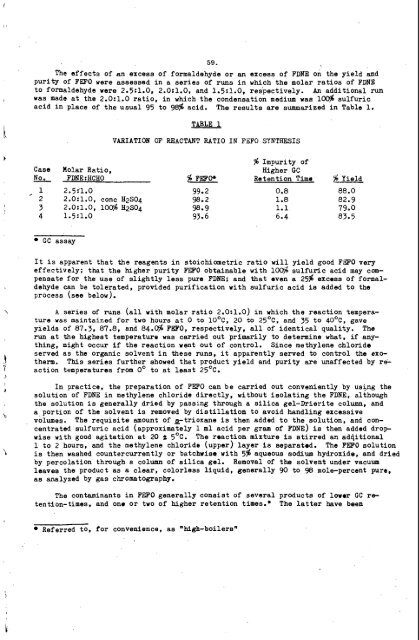secondary cells with lithium anodes and immobilized fused_salt
secondary cells with lithium anodes and immobilized fused_salt
secondary cells with lithium anodes and immobilized fused_salt
You also want an ePaper? Increase the reach of your titles
YUMPU automatically turns print PDFs into web optimized ePapers that Google loves.
59.<br />
The effects of an excess of formaldehyde or an excess of FDNE on the yield <strong>and</strong><br />
purity of FEFO were assessed in a series of runs in which the molar ratios of FDNE<br />
to formaldehyde were 2.5:1.0, 2.0:1.0, <strong>and</strong> 1.5:1.0, respectively. An additional run<br />
I was made at the 2.0:l.O ratio, in which the condensation medium was loo$ sulfuric<br />
acid in place of the usual 95 to 98$ acid.<br />
TABLE 1<br />
The results are summarized in Table 1.<br />
VARIATION OF REACTANT RATIO IN FEFO SYNTHESIS<br />
Case Molar Ratio,<br />
No. FDNE:HCHO $ FEFW<br />
-<br />
1 2.5:'l.O 99.2<br />
' 2 2.0:1.0, conc ~ 2 ~ 0 4 98.2<br />
3 2.0:1.0, IO& ~12~04 98.9<br />
4 1.5:l.O 93.6<br />
CC assay<br />
$ Impurity of<br />
Higher CC<br />
Retention Time % Yield<br />
0.8 88.0<br />
1.8 82.9<br />
1.1 79.0<br />
6.4 83.5<br />
It is apparent that the reagents in stoichiometric ratio will yield good FEFO very<br />
effectively; that the higher purity FEFO obtainable <strong>with</strong> 1@ sulfuric acid may com-<br />
pensate for the use of slightly less pure FDNE; <strong>and</strong> that even a 25% excess of formal-<br />
dehyde can be tolerated, provided purification <strong>with</strong> sulfuric acid is added to the<br />
process (see below).<br />
A series of runs (all <strong>with</strong> molar ratio 2.0:l.O) in which the reaction temperature<br />
was maintained for two hours at 0 to 10°C, 20 to 25'C. <strong>and</strong> 35 to 4OoC, gave<br />
yields of 87.3, 87.8, <strong>and</strong> 84.M FEFO, respectively, all of identical quality. The<br />
run at the highest temperature was carried out primarily to determine what, if anything,<br />
might occur if the reaction went out of control. Since methylene chloride<br />
served as the organic solvent in these runs, it apparently served to control the exotherm.<br />
This series further showed that product yield <strong>and</strong> purity are unaffected by reaction<br />
temperatures from 0' to at least 25'C.<br />
In practice, the preparation of FEFO can be carried out conveniently by usipg the<br />
solution of FDNE in methylene chloride directly, <strong>with</strong>out isolating the FDNE, although<br />
the solution is generally dried by passing through a silica gel-Drierite column, <strong>and</strong><br />
a portion of the solvent is removed by distillation to avoid h<strong>and</strong>ling excessive<br />
volumes. The requisite amount of e-trioxane is then added to the solution, <strong>and</strong> concentrated<br />
sulfuric acid (approximately 1 ml acid per gram of FDNE) is then added drop<br />
wise <strong>with</strong> good agitation at 20 t 5'C. The reaction mixture is stirred an adqitional<br />
1 to 2 hours, <strong>and</strong> the methylene chloride (upper) layer is separatod. The FEFO solution<br />
is then washed countercurrently or batchwise <strong>with</strong> 5s aqueous sodium hydroxide, <strong>and</strong> dried<br />
by percolation through a column of silica gel.<br />
Removal of the solvent under vacuum<br />
leaves the product as a clear, colorless liquid, generally 90 to 98 mole-percent pure,<br />
as analyzed by gas chromatography.<br />
The contaminants in FEFO generally consist of several products of lowor CC re-<br />
tention-times, <strong>and</strong> on. or two of higher retention times.* The latter have been<br />
Referred to, for convenience, as "high-boilers"

















